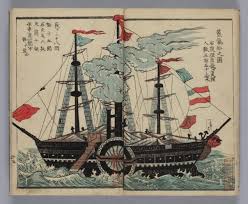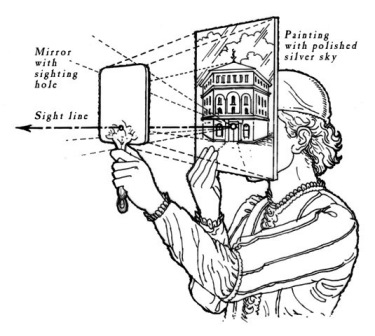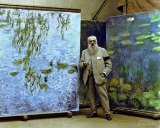 Loading... Please wait...
Loading... Please wait...All prices are in All prices are in GBP
Categories
- Home
- Blog History Revisited
- Impressionism
Blog History Revisited - Impressionism
Science & Technology = Art Revolution
Posted by ©Sandra Ker, Antiquarian Print Gallery, South Australia 1989-2015. Antique Prints and Maps Dealer http://www.historyrevisited.com.au on 14th Oct 2015
Waldemar Janszczak and His Impressionism Investigation

Recently a client introduced me to the work by a British art critic and television producer, Waldemar Januszczak. Jane sent me “The Impressionists: Painting and Revolution”. Methinks, “This will be great to listen to while I work on other activities…” WRONG! I happened to be uploading Science and Technology orientated prints dating from 1788 being constantly astounded by the depth of understanding. The knowledge of electricity and its storage and conduction amazed me, and in the year of the first Fleet arrival in Australia! Waldemar was introducing me to other early 19th century scientific revelations and inventions required by the Impressionists to achieve their successful “revolt” against the entrenched Parisian Salon Establishment Regime. He starts out by remarking how mainstream Impressionism has become, from poster-art to stubbie holders, fashion and chocolate box decoration. We all grew up with impressionist images counting down the months before Saint Nicholas visited the house.
Right Place. Right time.

France had a new Emperor, Napoleon III. Old Paris was being reinvented, replaced by new concepts of urban planning by Baron Haussmann between 1853-1870. Medieval Paris was swept away replaced by the eras new technology, consolidated the Railway system, established wide avenues etc. this sense of change was exciting and concerning in equal measure. young poor art revolutionaries need the Age of Enlightenment and the inventors of the Industrial Revolution to succeed after their first Paris exhibition in 1874. The new tools of their trade, like the "flat brush" and modern inventions like the portable paint tube, and knowledge of perspective and vision.
This new breed of restless artist was against the requirement of the entrenched " highly finished polished art" demanded by the Academicians of the powerful Salon in the mid-1800s. With all this control where was the innovation that younger generations yearn for?
Modern Transport Advantages

Impressionist were about spontaneity, requiring easily accessed materials, portable equipment, new materials, new inspirations, cheaper transportation methods. Here is where the new steam engine technology assisted them in their quest : on land they had trains and trams enabling quick access to hitherto difficult to reach locations, the steam-driven metal ships made ocean travel quicker and access to new cultures and art. In 1853 a US naval fleet under the command of Matthew Calbraith Perry (1794-1858) forced Japan to enter into negotiations with the US about an opening of the country for trade with the United States. Great for US to be sure. Meanwhile the Western Art World was in wonderment of its alien society. Britain's Gilbert and Sullivan wrote the Japanese inspired The Mikado, still a favourite with Opera groups and the public at large. For the restless Parisian artists looking for inspiration and solutions, Japanese woodblock art was a tsunami of opportunity. The future Impressionists were impressed by the Japanese use of 'pure colour' and recording the incidental "everyday floating world" (Ukiyo-e).
Monet and Japan

A major Australian Claude Monet Exhibition n 2001, Monet and Japan, reinforced the vital importance of this exposure in his lifelong quest to “paint light”, to achieve vibrant translucency. A memory of a exhibition visitor gasped “his work doesn’t look Japanese!” remains with me. Monet was not wishing to ape the Japanese style of art but to utilize how they used colour. Monet coated his walls with many famous Japanese Woodblocks as inspiration. Monet adapted what he saw to spontaneously portray sunshine, shadow...what “colour” is a shadow anyway!
Freedom of Tubes of Paints

European artists needed to venture out of the studio and be exposed to the changing impact of light out in nature. That would require lighter, portable easels, paint tubes, new brushes, knowledge of human vision. The tools enabling such portability had been invented to assist these art revolutionaries: the metal paint tube for one! Invented in 1841 by American oil painter John Goffe Rand as a way of transporting paints to use outside was patented by his employer patented by William Windsor to be closely followed by the screw-top cap. The tubes were in fact syringes which were used to squeeze out paint and preserved the paint for a longer time, allowing artists increased flexibility. Artist Pierre-Auguste Renoir is quoted as saying that, "Without paint in tubes there would have been…nothing of what the journalists were later to call Impressionists." Claude Monet headed outside to paint ‘en plein air’ to ‘capture the snapshot’, thus celebrating the everyday and changing the art world forever. The portability of paint tubes was integral to such practices. Winsor and Newton established their art supply business in 1832.With their shared interest in painting it turns out their skills complemented each other: Newton being the better painter and Winsor providing the scientific knowledge that would prove so important.
History of Scientific observation and Artistic interpretation
 “The Science of Art: Optical Themes in Western Art from Brunelleschi to Seurat” explores Fillipo Brunelleschi ’s invention of Perspective c.1420 and how it was explored by Leonardo Da Vinci and Albrecht Durer to a discussion on “Colour Theory” from the Aristotelian tradition of Primary Colours (4th century BC) to Isaac Newton’s “Prismatic Theory" in 1740 about light consisting of colours and how it impacted on J.W.M. Turner (maybe the earliest "Impressionist), Seurat and others. Then there is the Chemistry of Colour: how colour informs us of the chemical composition of “things”, a type of Psychological Spectroscopy (http://www.colour-affects.co.uk/history-of-colour)
“The Science of Art: Optical Themes in Western Art from Brunelleschi to Seurat” explores Fillipo Brunelleschi ’s invention of Perspective c.1420 and how it was explored by Leonardo Da Vinci and Albrecht Durer to a discussion on “Colour Theory” from the Aristotelian tradition of Primary Colours (4th century BC) to Isaac Newton’s “Prismatic Theory" in 1740 about light consisting of colours and how it impacted on J.W.M. Turner (maybe the earliest "Impressionist), Seurat and others. Then there is the Chemistry of Colour: how colour informs us of the chemical composition of “things”, a type of Psychological Spectroscopy (http://www.colour-affects.co.uk/history-of-colour)
Monet's Lily-ponds: His Most Revolutionary Work

Now for a Medical scientific observation of a leading British ophthalmologist in "The World Through Blunted Sight" Dr. Patrick Trevor-Roper examines the consequences of eye health through history and how it influence artist's perception and thus their art offerings. The book combines his professional knowledge of ophthalmology with his extensive familiarity with art and literature to fascinatingly examine the work of painters, sculptors, poets and prose writers. Looking at the effects of myopia, cataracts, colour blindness, squints and total blindness he speculates on what the impact would have been on artists had assess to modern technology to correct these issues. Indeed, Waldemar completes his Impressionism journey with the effect of age-related cataracts on Monet’s last project aged 86. At the of World War I, he set out to realize a dream to paint a set of giant waterlilies to surround the viewers. This effect of his cataracts altered the colours he perceived: the yellowing of his vision altered his perception of blue to grey for example. Eventually the quality of vision was very blurred in spite of eye operations and use of correcting glasses. He relied on reading labels to identify the colours used. However, far from hindering his art it is considered to have helped his Lily-ponds canvases to be the epitome of the Impressionism. His obsession with water was perfectly serviced by this affliction as he relied on his imagination and instinct. He was the last of the Impressionists dying in 1926. This was his last revolutionary offering.
© Sandra J Ker, South Australia
Recent Posts
- » Lady Sarah Lennox, King George III & The Honourable George Napier
- » Schomburgk's Botanic Garden & Park Plan, 1874
- » "City of Adelaide" Clipper Ship - What is Old Is New Again
- » Napoleon, Hudibrastic Poetry, Doctor Syntax & the Power of Satire
- » Colonial Melbourne to Albury "Parlour Car" Photo Connects to Adelaide Past & Present





